Take a Hike and Eat Some Dirt
Finding joy in the dirt, delight in the mess, and dinner in the woods.
Sorry if that sounds like a schoolyard insult, but I promise I mean it with love. There’s something deeply satisfying - almost rebellious - about cooking outside; hands in the soil, fire at your feet, and the wind doing whatever it wants with your mise en place. You strip away the noise and find yourself face to face with food in its most natural element. No ring light, no microgreens - just flame and instinct.
I’ve always believed that how and where we cook changes the food. It also changes us. When I’m outside, with a pocketknife in one hand and an apple in the other, I’m more attentive. More forgiving. I’ve made dinner under a tattered tarp in a thunderstorm, simmered oatmeal on a cliffside while watching the sun rise, and once forgot to season the chicken for a foil packet meal and still watched people scrape their plates clean. That kind of cooking doesn’t aim for perfection. It aims for presence.
And yes, more often than not you do literally eat a little dirt.
Why Now? A Wet Hike, A Warm Fire
I’m writing about this now because I just had the pleasure of taking a long over due trip that reminded me exactly why I care about cooking outside.
A few days ago, I had the chance to spend time with two remarkable groups - Treetop Journeys and Camp Yoshi - organizations dedicated to creating meaningful outdoor experience, especially for city people that are somewhat deprived of nature. I was invited to join one of their excursions not as a guest, but as something closer to a stage: helping the chef prep and serve a meal for a group that had just finished hiking six miles (in the pouring rain.)
I’m talking soaked socks and muddy boots clumping like clay. But when they returned to the trailhead and smelled the scent of charcoal and roasted veggies drifting through the trees, you could see their attitude shift. People gathered around carefully set picnic tables, hands outstretched, shoulders easing. I watched them come back to life plate by plate.

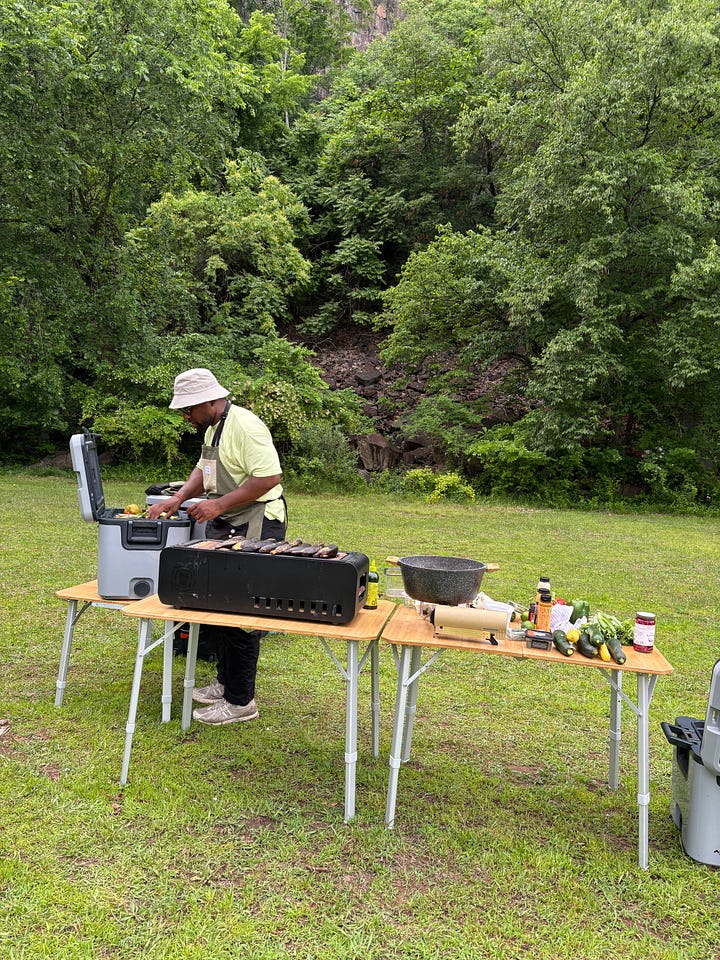
There was no molecular gastronomic endeavors. No fancy preparations or Michelin-style plating. Just nourishment, warmth, and presence. Cooking outside that day reminded me that context changes flavor. And when the contexts includes discomfort, hunger, exhaustion, and relief - the food doesn’t just feed you. It grounds you.
That’s what this post is about. The joy, the grit, the intimacy of food made under open skies and shared under trees. The kind of meal that tastes like a story you’ll tell forever.
Campfire Cuisine, Circa Age 11
I was a summer camp kid. Sorry - I wasn’t just a summer camp kid, I was that kid at summer camp. The one who loved summer camp. And I’m not talking about friendship bracelets or gossiping about boys back home. I loved backpacking. Anytime a trip was announced during a meal at the Tucker Inn, I was the first soul to sign up.
I loved it so much that for a brief moment I was convinced I wanted to become a nature guide. (Given that I’ve since decided to become a chef, I’m sure my parents are grateful my brother always wanted to go into business.) But there’s something about that kind of exhaustion - the kind that comes from hauling your own shelter through the woods, pushing past the point of comfort - that makes the reward feel earned. If you’ve ever watched a North Carolina sunset from the top of a ten-mile summit, you know what I mean.

And honestly, the more I think about it, that’s exactly what draws me to cooking. The most rewarding meals are often the ones that come with a little bit of fuss. Whether it’s balancing microgreens with tweezers on top of uneven roast chicken skin or trying to light a camping stove in the pouring rain - it’s the effort that makes it taste better.
The best meal I’ve ever had - the one that tastes like a story I will tell forever - happened when I was eleven, on my first-ever overnight backpacking trip somewhere deep in the Blue Ridge Mountains. I must’ve looked absurd with a pack that dwarfed my 4’6” frame. Gear was divided among our ragtag group of adventurers, and I was assigned the most precious cargo of all: dinner. Chicken fajitas with quinoa and roasted vegetables. A woodland delicacy.
The chicken came in a pouch. I was scandalized. My part-Asian, rice-most-nights upbringing had never so much as glanced at quinoa, and suddenly it was dinner. I think it’s safe to say I was terrified of the food in front of me. Which says a lot, considering I was the kind of child who once told her pediatrician that her favorite food was salmon and asparagus.
Our trip guide - who I now understand was almost certainly a very tired college student - taught us how to light the stove. We took turns sautéing vegetables, boiling quinoa, and warming up the mystery poultry in the great outdoors. And not to be dramatic, but that meal? That weird, kinda soggy, kinda dirt-ridden wrap of “chicken”? It was the best meal I’ve had in my whole life. I am a thousand percent confident that nothing will ever top it. Ever.
And maybe that’s because outdoor cooking, in all its smoke and struggle, brings us back to what food has always been: resourceful, communal, born of fire and shared effort. That dinner by the river? It wasn’t just a meal. It was a rite of passage. And that’s exactly that kind of flame I’m still chasing, all these years later.
A Brief History of Cooking Outside
Before the kitchen was tiled and temperature-controlled, it was just a patch of earth and a fire. Cooking outside isn’t a trend - it’s our oldest shared ritual. Some archaeologists estimate humans have been cooking with fire for nearly 2 million years. The earliest evidence of controlled fire use comes from a site in what’s now Kenya, where hominins gathered around hearths - not just to eat, but to stay warm, to gather, to tell stories.
The anthropologist Richard Wrangham famously argued in Catching Fire that cooking was the evolutionary shift that made us human. “Cooking,” he wrote, “co-evolved with humanity. It’s not just something we do - it’s something that made us who we are.” Fire softened our food, sure. But it also softened us - into social, collaborative beings. Around a fire, we connect with one another.
In cultures across the world outdoor cooking isn’t a novelty. Think of Japanese robatayaki, where fish and vegetables are grilled over hot charcoal in front of diners. Or Argentine asado, a whole ritual of slow fire-roasted meats and time spent in the open air. In West Africa, street-side open flame cooking is both cooking and economy. Even American cookouts - from Texas brisket pits to Hawaiian whole-hog roasts - are less about the food and more about the people you gather with to tend the flame.
And yet, in a modern culinary world obsessed with precision, open-fire cooking still resists control. It demands presence. No two flames behave the same way. Your ingredients talk back. Wind, wood, heat - all of it becomes part of the recipe. It’s both humbling and empowering.
Maybe that’s why it’s having such a resurgence. From high-end chefs rediscovering ancestral techniques to trail cooks whipping up Michelin-level meals on portable stoves, cooking outside feels like a return - to the elemental, the tactile, the real. If you aren’t already, I would highly recommend familiarizing yourself with Francis Mallmann’s Patagoninan fire feasts or the incredible open fire work Mads Refsund is doing at his restaurant Ilis.
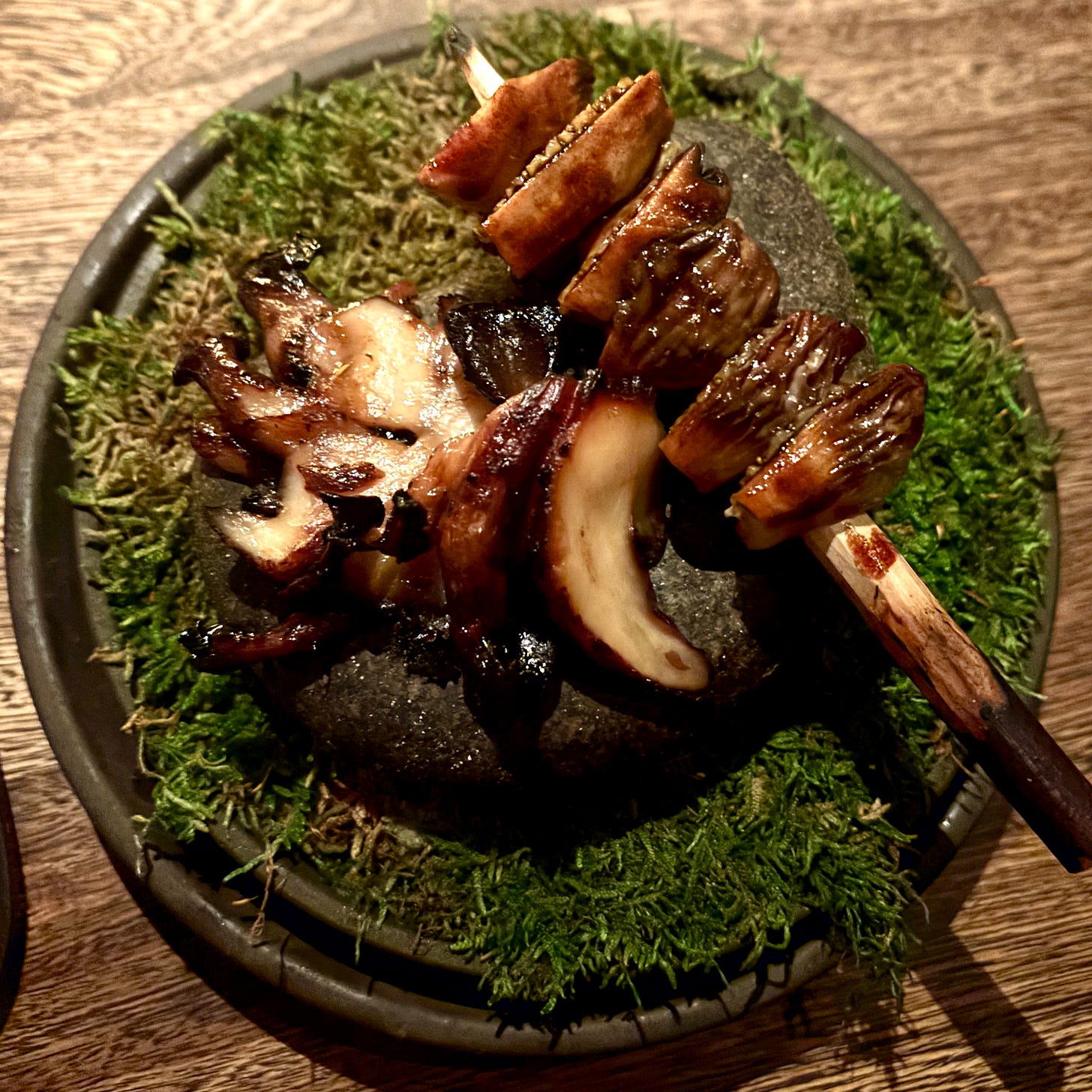
Community in the Wilderness
There’s something about cooking outside that makes the line between “chef” and “everyone else” blur in the best way. One person fans the flame. Another peels garlic with chilly, dirty fingers. Someone else stands guard over the pot like it’s something precious. You fall into a rhythm - pass the salt, stir the pot, hold the flashlight - and before you know it, dinner is no longer a task but a tiny, collaborative miracle.
That kind of shared labor builds something sacred. I felt it most with Treetop Journeys and Camp Yoshi. We were basically in a full-on-tug-of-war with the weather. One minute the sun was out, the next it was pouring like the sky was out to get us or something. We spent most of the afternoon throwing tents up, then pulling them down when it seemed like the storm had passed - only to throw them back up again when the wind picked up and realized it was far from over.
Tents help, but only so much.
While Rashad and I cooked, his friends and content crew worked as an unofficial pit crew - keeping rain from pooling above us, swatting it off with tongs, spatulas, whatever we had nearby. Someone stood guard over the T-bone like it was priceless art, shielding it from the downpour so it stayed just right. It was chaotic and funny and weirdly beautiful. Total team effort.
The things is, outdoor meals ask something of you. They’re not passive. They require presence. You can’t scroll while tending an open flame. You can’t zone out when wind keeps trying to blow your pot over. That physical attention pulls you into the now - and it pulls everyone around you in, too. You stop being strangers and become something closer: co-conspirators in the pursuit of hot food. (And I know this to be true, because I met the Camp Yoshi team just an hour before we started meal service, and I left that evening understanding I had gained some forever supporters)
And then there’s the eating itself. No formal table. No plated courses. Just a ring of bodies, cold hands wrapped around warm bowls, some squatting on stumps, others on flat rocks or backpacks. The seating chart is chaos. The dress code is waterproof. But the vibe? Intimate. Immediate. A meal like that doesn’t ask for manners - it asks for generosity
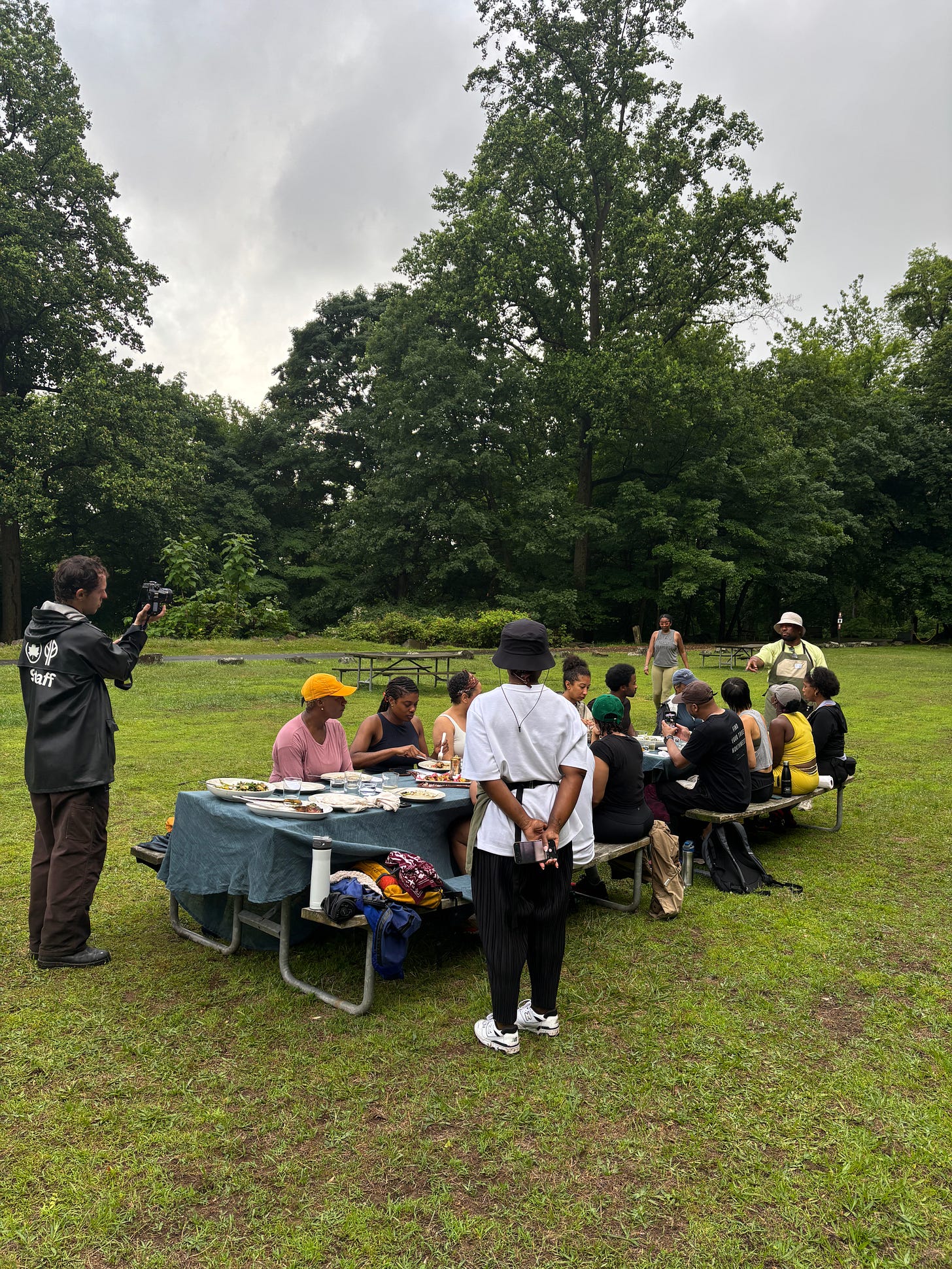
I was most excited to be reminded of the sense of community that forms from dining outdoors. Not in the curated dinner party way, but in the slightly messy, deeply human way that only happens when everyone’s a little dirty, a little hungry, and entirely present. It felt strangely, like a kind of luxury. Not the kind with white linens and foie gras, but the kind where you’re fed, seen, and a little changed by the company.
It reminded me that cooking doesn’t have to be performative to be powerful. That the best meals aren’t always the most refined - they’re the ones that bring people together around a fire, a pot, a shared hunger.
You don’t need a reservation for that. Just a flame and a few hands willing to help.
Recipes for the Trail
The things about cooking is that it forces you to let go - of perfection, of plating, of the idea that good food has to come from a full kitchen. You start to realize that all you need is flame, fuel, a few pantry staples, and someone to share it with. These recipes aren’t meant to impress Michelin inspectors. They’re meant to taste amazing after you’ve spent the day clambering over rocks, getting sunburned, or trying to remember how to read a compass.
Below are just a few things I’ve cooked - or cobbled together - in the woods that stuck with me. They’re not fancy. But they made me full and happy in the kind of way you only get when your tired, grubby, and surrounded by trees.
Trail Risotto
1 cup instant rice or quick-cook farro
1 pouch cooked lentils or beans
1 bouillon cube
Handful of dried mushrooms or sun-dried tomatoes
Glug of olive oil
Optional: a tiny wedge of Parmesan, packed lovingly in beeswax wrap
Boil 2 cups water with bouillon and dried veggies until softened. Stir in rice/farro and beans until everything is warm and saucy. Finish with olive oil and find some sort of makeshift cheese grater if you brought the Parm. It’s basically risotto if you close your eyes and breathe deeply.
Tacos in a Bag
1 snack-size bag of Fritos (or Doritos, if you’re feeling bold) per person
1 pouch seasoned black beans or taco meat substitute
Handful or shredded cheddar or crumbled queso fresco
Packed of hot sauce or salsa
Optional: lime wedge, pickled jalapeños, or that one sad avocado you’ve been protecting since mile two
Warm the beans or lentils in a pot over a camp stove. Spoon the warm filling inside your Frito bag, sprinkle with cheese, hit it with hot sauce or lime, and fork it up right out of the bag. It’s crunchy, it’s salty, it’s hot and gooey in all the right ways. Bonus: no dishes.
Fire-Roasted Banana Boats
2 ripe bananas (the spottier, the better)
Handful of chocolate chips or chopped dark chocolate
Mini marshmallows or a couple big ones torn into pieces
Crushed graham crackers, toasted nuts, or granola for crunch
Optional: peanut butter packet, flaky salt, cinnamon
Slice each banana lengthwise down the center, being careful not to cut all the way through the bottom peel. Gently open them up like a canoe. Fill the inside with chocolate, marshmallows, and whatever toppings you’ve smuggled into the woods. Wrap tightly in foil and tuck them into the coals of your campfire for about 8-10 minutes until melty and caramelized. Unwrap and dig in! It’s s’mores-adjacent but a little more elegant in a feral, fireside kind of way.
So, Go Take a Hike
Cooking outside isn’t just about food - it’s about connection. To the land, to the people you share the meal with, and to yourself. It’s about embracing the unpredictability of the elements, the thrill of fire and smoke, and the slow, satisfying ritual of turning raw ingredients into something nourishing. Whether it’s a soggy bag of tacos by a river or a perfectly seared T-bone in a rainstorm, these moments stick with us because they blend challenge, creativity, and community into something unforgettable.
So next time you’re tempted to stay indoors and rely on the predictable hum of your stove, consider packing up a few simple tools and heading outside. Light a fire, breathe the fresh air, and let the wildness of open flame remind you why cooking is magic.
After all, outdoor cooking isn’t just history; it’s a way forward. A chance to slow down, gather close, and eat some dirt with a smile.
Thank you to Jacob at Treetop Journeys and Rashad at Camp Yoshi for reminding me how much joy this activity brings me - and for inspiring this post.
Catch you around the campfire,
Lily

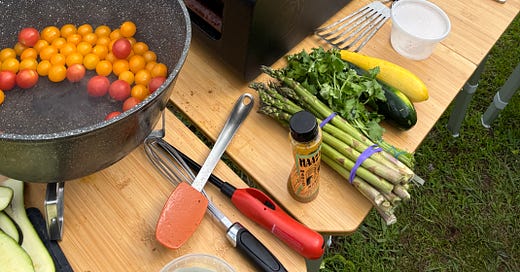



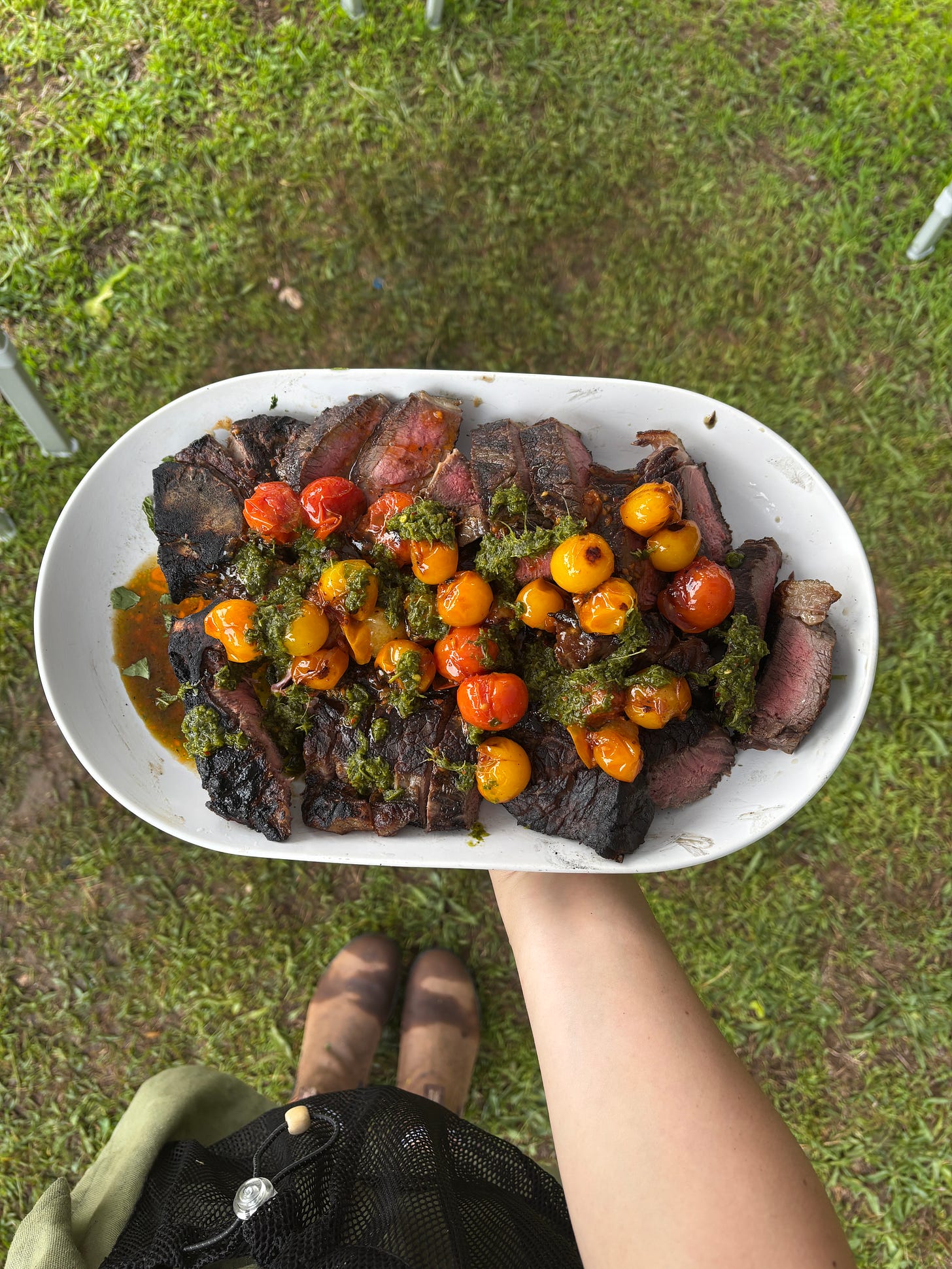
Loved this. ❤️